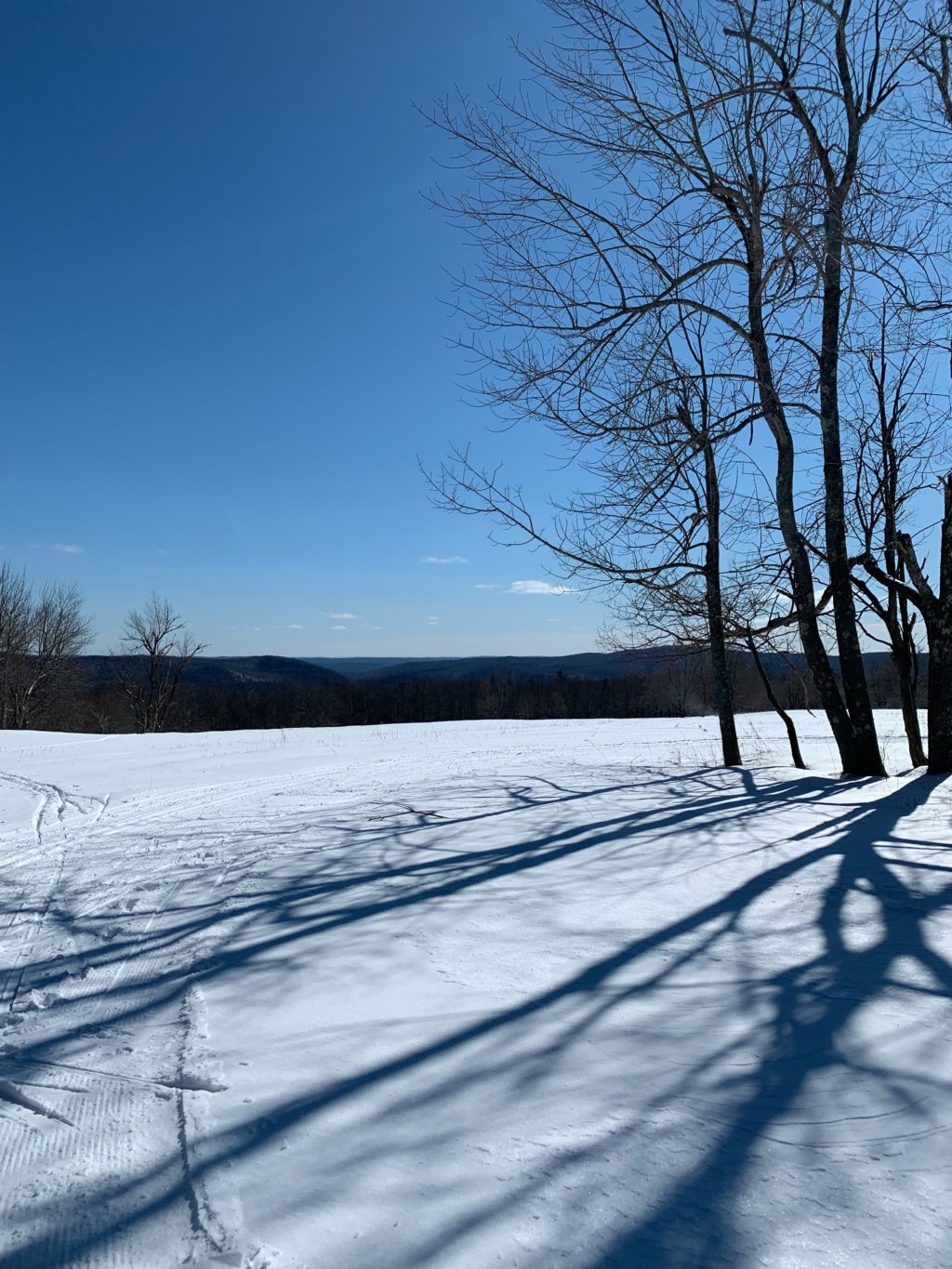Almanac: Blue

A cerulean sky captured recently while cross country skiing at Notchview. Photo: Aurora Braun.
It’s been a perfectly wretched winter for cross-country skiing here in the Valley (although last week we did, finally, get a dump). It was a joy, therefore, to be up in northern Vermont a couple of weeks ago for some skiing at Craftsbury Outdoor Center, with its extensive network of trails through woods, across fields, and over frozen lakes.
It was very cold when my companions and I set off early, but the sun was brilliant and the air calm. With the exertion we were soon comfortable. The cloudless sky was a strikingly deep shade of blue, lighter than Navy but darker than robin’s egg and with an unusual richness and depth of color. It was, in fact, the very definition of cerulean blue—“cerulean” from Latin roots for “sky.” We had paused in the middle of a long climb and were talking about children…and grandchildren…and how they often asked simple, but profound, questions such as “Why is the sky blue?” One of my friends, more to himself than to us, said, “Ya know, why is the sky blue anyway?”
I was about to offer up the standard-issue explanation: “It’s because the atmosphere preferentially scatters blue light.” But then I realized I actually had no idea what that meant. “Atmosphere?” Did that mean molecules of oxygen or nitrogen? Or dust? Or water? “Scattered?” Huh? Scattered how? Off of what? And why blue and not the other colors of the spectrum?
So I kept my trap shut. I just soaked in all that blue and noticed within me a familiar, vaguely unsettled, but also vaguely pleasurable, feeling of unsated curiosity.
Back home I sought an answer—which turned out to be harder than I expected. I found a lot of variations on the inadequate one-sentence “explanation” that came to my mind on the trail, plus quite sophisticated and mathematical answers involving things like “Rayleigh scattering,” as though that explained everything.
Eventually, though, I found some answers that were detailed enough to satisfy but not so detailed that I needed a PhD in physics to understand them.
Before going any further down this particular rabbit hole, we need to acknowledge—then quickly ignore—a fundamental mystery of light—meaning that it can act as a particle or a wave. Or both. It’s confusing. For now, let’s stick with visualizing light as waves, with the colors of light described by waves of differing frequencies—relatively fast/short for light at the blue end of the visible spectrum, and slower/longer at the red end. Violet light, for example, has a wavelength of roughly 450 nanometers (billionths of a meter), while red light has wavelengths of roughly 680 nanometers.
The curious bit here is that when wavelengths of light interact with the charged particles* in atoms (electrons and protons) those particles are stimulated and start vibrating at the same frequency of the light doing the stimulation. That “vibration” produces its own “light,” except instead of coming from the sun, it’s coming from the zillions of stimulated oxygen and nitrogen atoms in the atmosphere. That re-directed light is said to be “scattered.” The shorter the initiating wavelength, the more scattered light is produced. Blue light is scattered almost 10 times as efficiently as red light.

How deeply blue the sky appears depends, among other things, on how much moisture the air contains. Water droplets—even microscopic water droplets—are way larger than atoms, so they don’t react the same way. They don’t scatter light, they reflect it—and they reflect all wavelengths roughly equally, meaning as white light. The more water in the air, the more the fundamental cerulean blue is diluted and obscured by the milky white of the moisture-reflected light. That’s also the reason the sky color lightens close to the horizon—the light is travelling through a lot more water droplets than when you look straight up.
Actually, violet light is scattered even a bit more strongly than blue, but our eyes are more sensitive to blue light than violet. To my eyes, the cerulean blue of a clear winter’s sky does seem to have some kind of deep violet component. I think that’s why it feels so striking. The effect is more common in winter because the air is generally so much drier than in warmer months.
If you’ve noticed the photo credits above, you can guess that I had a second chance to delight in cerulean skies. After last week’s snowfall my youngest daughter and I went skiing at Notchview, one of the state’s largest Nordic centers. As at Craftsbury it was a cold, perfectly clear morning. The contrasts that day between the majestic sky, the dark trees, and the brilliant snow were just breathtaking—one of the great gifts of winter!
* OK…again with the particles vs. wave thing. Like light, atomic “particles” aren’t really either particles or waves—they’re quantum probability wavefunctions. I have no idea what that means. I’m just noting this here because some of my readers actually do understand things like this. Perhaps my confession of ignorance will inspire one of them to offer an explanation in the comments section.
Almanac is a regular Indy column of observations, musings, and occasional harangues related to the woods, waters, mountains, and skies of the Pioneer Valley. Please feel free to comment on posts and add your own experiences or observations.

1 thought on “Almanac: Blue”